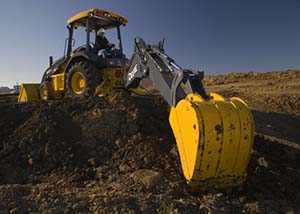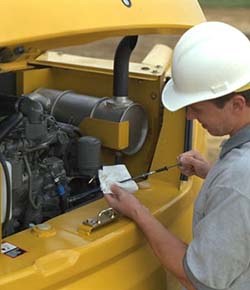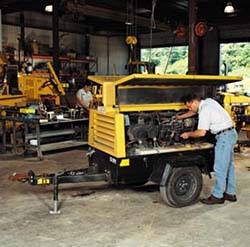Diesel Digest
 Machines need hearts of steel. The diesel engines that generate the fiery power of construction equipment are put to the test on a daily basis, performing in extreme heat and cold in the toughest of environments. Just because an engine is tough as nails doesn’t mean it can’t appreciate a little love and care now and again.
Machines need hearts of steel. The diesel engines that generate the fiery power of construction equipment are put to the test on a daily basis, performing in extreme heat and cold in the toughest of environments. Just because an engine is tough as nails doesn’t mean it can’t appreciate a little love and care now and again.
By establishing a preventive maintenance program for your diesel engine, you can ensure that your power plant receives the long-term love that will allow it to spearhead each day of hard-nosed work in the most strenuous of operating conditions (from dust and heat to rain and debris). Before a maintenance program is initiated, it’s important to remember that your diesel engine is more than just a power source.
“Your engine is an integrated system of components that work together to deliver maximum performance, so maintaining your engine’s fuel, lubrication, air intake, cooling and electrical systems properly will help to provide a long service life,” says Grant Suhre, manager of field service with John Deere Power Systems, a top manufacturer of off-highway diesel engines. In addition, the operator’s manual provides a detailed description of recommended service requirements at various intervals. Following these service requirements will also help ensure that your engine delivers many years of dependable service.
Fuel for Thought
“An unrestricted and uncontaminated fuel flow is obviously very important in assuring the proper operation of your diesel engine,” Suhre says. Fuel is the lifeblood for your engine’s constant output of energy. Therefore, when performing fuel system maintenance, remember to:
- Check for leaks.
- Check for bent, kinked or dented supply or return lines that might cause a restriction.
- Inspect fuel filters for dirt, water or other foreign matter.
- Use quality fuel that is not contaminated with water. Water in the fuel system is the greatest cause of fuel injection system failure.
- Check for water in the fuel filter. Water-separating fuel filters will remove most contamination. Daily inspection of the fuel filter and draining the water as required will ensure that the fuel system is protected.
- Install a fuel storage tank water-separating filter to
further protect engines by filtering out dirt and rust. IMPORTANT: The filter should not be used in
conjunction with fuel tank pumps of greater power than the filter was designed for. Also, to service the tank filter, install a shut-off valve between the tank and filter. The filter element should be changed annually or more often if fuel flow becomes restricted.
Lubrication Situation
Well-designed machinery lasts a long time if cared for properly. This care is especially crucial where lubricants protect critical components. That’s why compact equipment manufacturers make specific lubricant recommendations. Following those recommendations for periodic maintenance and using high-quality lubricants can protect machinery from wearing out prematurely.
“Lubricants are formulated to meet the demands of specific types of engines and their operating conditions,” Suhre says. “Unless the correct viscosity oil with additives in the proper proportion is selected, the lubricant might not meet the needs of a diesel engine.” Unfortunately, all lubricants gradually lose effectiveness during operation due to chemical and physical changes in the lubricant. The deterioration process is accelerated by contaminants from external and internal sources. That’s why a manufacturer’s recommended lubricant change interval for normal operating conditions is so important. More frequent changes are recommended when operating in extreme environments such as hot or dusty conditions. Using high sulfur fuels in diesel engines will also reduce the useful life of the oil. Oil analysis can be used to assure that the recommended service interval is adequate for your application.

- Change oil when recommended.
- Keep all lubricant containers covered in an area
protected from dirt and moisture. - Remove all dust and grime from both the container and service points before performing lubrication service.
Essential Air-Intake
Making sure your engine receives an unrestricted flow of clean air is imperative for proper operation. For example, dust reaching your engine through a leaking connector in the air-intake system can cause more damage (called “dusting the engine”) than a complete restriction of air flow. Therefore, it is important to:
- Inspect the entire air-intake system for openings that could draw in unfiltered air such as loose clamps or cracked hoses.
- Inspect dry, element-type filters and replace if clogged with dust or dirt. Inspect for damaged seams and pleats. Replace if damaged. Cleaning the elements with compressed air or by pounding them on a hard surface is not recommended.
- Using the correct replacement filter is critical. Contaminated air bypassing the filter seal is a common cause of premature engine failure.
Keeping Things Cool
When performing maintenance on your engine’s cooling system, always use the recommended class of coolant. Engine cooling systems should be thoroughly flushed, cleaned with a heavy-duty cleaner and refilled with clean coolant and inhibitors per the recommended intervals in the operator’s manual. In addition, it is important to visually inspect the radiator and thermostats for any signs of corrosion, debris or physical damage.
“We highly recommend coolant solution analysis,” Suhre says. “The coolant analysis will verify the chemical composition of your coolant and include a written report with maintenance recommendations for the coolant and cooling system.”
Also, make sure to:
- Replace radiator hoses that are cracked, soft or swollen.
- Clean all dirt and trash from between radiator fins and around the radiator itself.
- Check for bent radiator fins and straighten as needed.
- Ensure baffles and fan shrouds are in place and functional.
- Inspect the fan blades for damage and the fan belts for excessive wear or slippage. Replace as needed.
Electronic Controls

Maintaining the electrical system is often more complicated than maintaining some of the engine’s other systems, so most maintenance tasks should be left to a certified mechanic. However, an engine’s electrical system is centered on its battery, and it is always important to check the condition of your battery.
- Verify batteries are fully charged and the electrolyte is at its proper level.
- Remove battery cables and clean cable ends and posts.
- Repair or replace the alternator if it isn’t keeping the battery fully charged.
- Check all alternator wiring connections for tightness and corrosion. Correct as needed.
- Check all chassis grounding and bonding wires for corrosion and integrity.
- Check condition and tension of the alternator belt and adjust or replace as needed.
- Check all starting motor connections for tightness and corrosion. Correct as needed.
- Check all fuses and remove any corrosion or replace as needed.
- Check the engine control unit and its wiring connections to ensure they remain tight and are not damaged.

Comments are closed here.